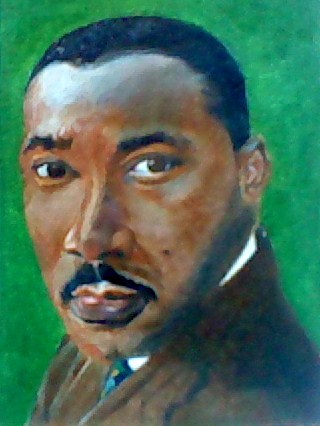 Over the past few years, I have tried to find new ways to celebrate MLK day. I’ve been to celebrations at city halls in various cities, variety shows showcasing drama, music, dance and other talents in honor of Dr. King. I’ve participated in marches to commemorate his legacy and watched television programs about his contribution to the Civil Rights Movement on this holiday. So this year, I decided to celebrate the memory of Dr. King by writing a blog article.
Over the past few years, I have tried to find new ways to celebrate MLK day. I’ve been to celebrations at city halls in various cities, variety shows showcasing drama, music, dance and other talents in honor of Dr. King. I’ve participated in marches to commemorate his legacy and watched television programs about his contribution to the Civil Rights Movement on this holiday. So this year, I decided to celebrate the memory of Dr. King by writing a blog article.
The first time I remember ever seeing a picture of Dr. King was in my home as a child when my dad was watching the Eyes on the Prize documentary, which was aired on PBS and, in rich detail, chronicles the Civil Rights Movement. I recall seeing segments of Dr. King giving speeches and sermons with his trademark ringing voice that aroused, at that time, an unexplainable surge of energy and emotion within me. I saw the footage of him leading protest marches, getting pelted with rocks, other protesters being attacked by police, dogs, and firemen with forceful blasts from water-hoses. Those images, along with other horrific photos such as African-Americans being lynched, hung from trees, and even having their bodies burned by racist mobs were, to say the least, eye opening. I was shocked to see such brutality; angered that people were treated so viciously because of the color of their skin, the same color as my skin. After watching that documentary as a child, I had many questions that I needed to be answered.
When I was in fifth grade, my elementary teacher passed out a book order form. These were forms from a particular company that our school partnered with in order to give students an opportunity to purchase books of their own choosing. It was exciting because it gave us the chance to select books on our own; books that interested us and not books that the teacher mandated we read. As I scanned through the lists of titles available for purchase, I came across one on the life of Dr. Martin Luther King, Jr. I asked my parents for money to buy the book and when it was delivered to me at school I couldn’t wait to read every page. My education on the Civil Rights Movement had begun! A few years later my parents took me and my brother to visit the Ebenezer Baptist Church in Atlanta, GA, where Dr. King gave many inspirational sermons in his career as a preacher. We were in Atlanta to attend one of the annual church conventions that my parents would take us to each summer (my father is a preacher as well) and we also got to visit the Martin Luther King Memorial there in Atlanta.
I’ve read so many impressive essays and speeches that Dr. King wrote over the years in which I’ve studied his life, including the collection found in The Autobiography of Martin Luther King, Jr. I pulled a book off of my bookshelf yesterday titled Bridges And Boundaries: African Americans and American Jews (George Braziller in association with The Jewish Museum, New York) which contains a visual essay including photographs of The Civil Rights Movement. In it, I found a picture of Dr. King giving a speech in 1968 to the Collection Local 1199 Union, a drug, hospital and healthcare employees union. My book indicates that in his speech, Dr. King addressed the union members saying “‘You have provided concrete and visible proof that when black and white workers unite in a democratic organization…they can move mountains.'” That message contains a powerful truth, and if practiced, prescribes a remedy for the many problematic divisions we still find present in today’s society, and which still, unfortunately, threaten our progress as a nation.
© 2012
